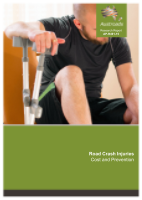Road Safety

- Publication no: AP-R491-15
- ISBN: 978-1-925294-67-5
- Published: 8 September 2015
- PDF (free) Download
This in-depth crash investigation study was conducted to provide information about the causes and costs of a sample of serious (hospitalised) injury crashes in NSW.
Between March 2010 and February 2013, participants were recruited following admission to participating NSW trauma hospitals due to injury as an occupant of a passenger motor vehicle. Participants were interviewed. The case vehicle and crash scene were inspected. Injury codes and cost data were obtained from hospital records. A multi-disciplinary Crash Review Team reviewed 94 crashes to agree on contributing factors, sources of injury, and recommended safety strategies, using a Safe Systems framework.
Results highlight that common errors often resulted at least in part from features of the road environment. The Crash Review Team suggested strategies to address negative behaviours, including changes to the road environment and licensing system. Suggested injury mitigation strategies focused on improving vehicle restraint systems and structural integrity, as well as removing unprotected nonfrangible poles and trees that are close to the carriageway.
Indices of driver fatigue collected from in-depth crash investigation were used to examine the set of operational criteria used in NSW to classify crashes as fatigue-related, via comparison with CrashLink data. Results suggest that fatigue-involvement in crashes would be improved by considering measures of specific fatigue risk factors (e.g. amount and quality of last sleep, duration of driving).
In addition to providing average costs of in-hospital treatment (including by various levels of person-, vehicle-, and crash-characteristics), the project provided an opportunity for a small prospective case series study examining costs of injury for six months following discharge. Results suggest that the substantial financial costs are borne mostly by Medicare, Workcover, and CTP insurance, though participants reported experiencing financial strain due to up-front payments. Other stressors included being unable to work or to perform various everyday activities, and attending many medical appointments. Facilitating claims procedures may improve post-crash experience, and education campaigns that highlight “everyday” consequences of injury may assist with reducing risky driving behaviour.
The present results should be interpreted in the context of methodological shortcomings. Implications for future in-depth crash investigation, and data linkage, are considered.
Report Update: 12 October 2015
A revised version of the report has been provided which outlines the collaboration with the Monash University Accident Research Centre and the Australian Crash In-depth Study (ANCIS) in the usage of study protocols, data collection and aligns the results with relevant reporting protocols. The amendments have not changed the findings of the report.
- Summary
- Purpose and methodology
- Crash causes and avoidance strategies
- Investigation of fatigue coding
- Real costs of treating injury due to crashes
- Study limitations
- Methodological implications for future in-depth studies
- 1. Introduction
- 1.1. Purpose
- 1.2. Methodological overview
- 1.3. Structure of report
- 2. Methodology
- 2.1. Sites
- 2.2. Inclusion and exclusion criteria
- 2.3. Recruitment and participants
- 2.4. Materials
- 2.5. Procedures
- 2.6. On-going costs study
- 2.7. Tracking and data-matching
- 2.8. Crash reviews
- 3. Causes of Crashes and Severe Injury and Safety Recommendations: Outcomes of Crash Reviews
- 3.1. Background
- 3.2. Results
- 3.2.1. Overview of crashes, vehicles and occupants involved in the study
- 3.2.2. Crash types and key events
- 3.2.3. Contributing crash factors
- 3.2.4. Contributors to key events
- 3.2.5. Common cross-cutting contributing factors
- 3.2.6. Factors contributing to injury severity
- 3.2.7. Strategies for crash avoidance
- 3.2.8. Strategies for injury mitigation
- 3.3. Discussion
- 3.3.1. Key events and the role of the road infrastructure and traffic management
- 3.3.2. Crash factors, injury severity factors and safety strategies
- 3.3.3. Convergence with safety strategies recommended in reports of South Australian in-depth studies
- 3.3.4. Study strengths
- 3.3.5. Study limitations
- 4. Investigation of the Coding of Fatigue: Comparison of Official Records with Self-Reported Information
- 4.1. Background
- 4.1.1. Issues in measuring fatigue involvement in crashes
- 4.1.2. Aim
- 4.2. Methods
- 4.2.1. Approach
- 4.2.2. Data sets
- 4.3. Results
- 4.3.1. Available fatigue crash data
- 4.3.2. Comparison of fatigue-related crash coding by CrashLink and the Crash Review Team
- 4.3.3. Comparison of fatigue-related and other crashes
- 4.4. Discussion
- 4.4.1. Limitations
- 4.4.2. Recommendations and conclusion
- 5. Real Costs of Treatment in Hospital, and On-going Costs, of Injury Due to Crashes
- 5.1. Background
- 5.2. Results
- 5.2.1. In-hospital costs
- 5.2.2. On-going cost case studies
- 5.3. Discussion
- 6. Some Comments Regarding In-Depth Crash Investigation, Linkage of Routinely-Collected Data, and Multidisciplinary Discussion of Crash Data
- References
